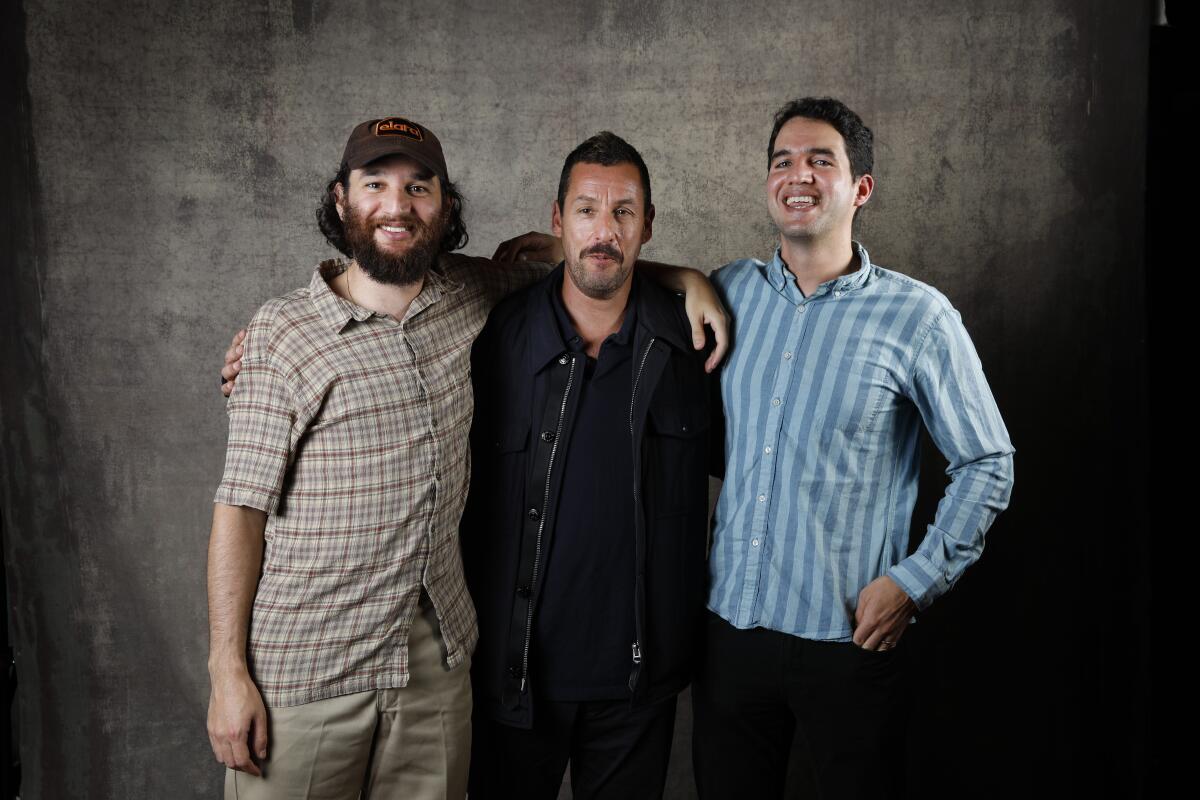Why the hands-on Safdie brothers found themselves shooting ‘Uncut Gems’ from a car trunk

- Share via
Every movie made by brothers Josh and Benny Safdie can be described as calamitous, propulsive and unbearably stressful. It was true of such micro-budget, pointedly plotless character studies as “Daddy Longlegs” and “Heaven Knows What,” and it’s certainly true of 2017’s white-knuckle thrill ride “Good Time” and their latest, the Diamond District crime saga “Uncut Gems.”
“It fits with the process of trying to make any movie,” Josh says, speaking at the West Hollywood office of their distributor, A24. “You’re getting all these things aligned, raising money, getting the right people, getting all these departments to mesh together. And that’s very stressful.”
“ ‘This could be the last movie we ever make’ is how we approach it every time,” Benny adds. “So we go for broke.”
The New York-based directors developed their distinctive aesthetic working as a tiny crew directing first-time actors, but lately their street-level depictions of New York grifters have earned them increased acclaim, bigger budgets and real movie stars. “Uncut Gems,” in which Adam Sandler plays Howard Ratner, a charismatic jeweler with a steady stream of debts and a head full of schemes, is perhaps their most ambitious work yet. Still, the brothers maintain their hands-on approach.
“There’s a bit of a sand castle quality to the filmmaking process,” Josh says, “where Benny is a boom operator and I’m involved with the picture and we both work with the actors.”
During the “Uncut Gems” shoot, the Safdies hopped into the trunk of a car — one lying on top of the other — to shoot a fight scene from the most advantageous angle. “People found it funny,” Josh says. “But there’s nothing funny about that — it’s practical.”
“A lot of it is utilitarian,” Benny says, “and yes, we get into fights, but we’re brothers and we’ll get over it. We complement each other in a lot of ways, and it helps us broaden our own visions of the world. And that, in turn, helps with the movie.”
The movie, set for a Christmas release, has a gritty realism that is in part informed by their father’s experience as a Manhattan jewel runner, but also by their documentary-like fealty to the historical record. That “Uncut Gems” is, somewhat inexplicably, a period piece set in 2012 is an example of form following function.
The film’s plot involves Ratner’s attempt to sell a mystical Ethiopian gem to a basketball star, but since the Safdies’ production schedule got shifted into the NBA season, they couldn’t hire a contemporary player for the role. So they tried the next best option.
“We had to find somebody recently retired who looked like they could be who they were back then,” Benny says. “Once we talked to [former Boston Celtics star] Kevin Garnett, we could tell he had the passion and the ability to act.”
The plot required showing NBA games, so the Safdies had to find the right ones in order to meet fair-use standards. “So we printed out schedules from 2008 up to Garnett’s retirement to figure out when he was geographically in range of New York City,” Benny says. Then, once they secured the participation of R&B star The Weeknd — who also plays himself — they had another restriction, because it wouldn’t make sense to have him play a New York club gig before 2012. So 2012 it was.
“I think you create your best work when you’re surrounded by restrictions,” Josh says.
They also filmed “Uncut Gems” on anamorphic 35mm, hardly the easiest choice for a frantic urban shoot. “We wanted an organic feeling,” Josh says. “There’s an old-world vibe on 47th Street that you can’t escape, that feels barbaric. Our cinematographer, Darius Khondji, said that this movie is about faces. And he said the anamorphic lens makes the face feel present.”
“We actually had to defer some of our payment to shoot on film,” Josh adds. “It was that important to us.”
Another non-negotiable element of “Gems” was the participation of Sandler. The Safdies spent years pursuing him for the role, and he turns in an ace dramatic performance as the passionate, exasperating Ratner.
“He has the ability to internalize the absurdism of everything,” Benny says. “But still, he roots the character in this real feeling, like, ‘Oh, it’s happening to that guy.’ ”
“He works so hard at everything,” Benny says. “We did so much prep on this movie to understand who this character was. We did test shoots, where he was just hanging out for four hours while we were filming it — trying to understand what Howard does, how he talks, how he watches basketball.” They saw him as a quintessential “local celebrity,” the kind Manhattan produces on every street corner.
Will the Safdie brothers ever make a film outside their Big Apple home turf? “We try to get out,” Josh says. “But most people who try to leave, they can’t.”
More to Read
Only good movies
Get the Indie Focus newsletter, Mark Olsen's weekly guide to the world of cinema.
You may occasionally receive promotional content from the Los Angeles Times.









